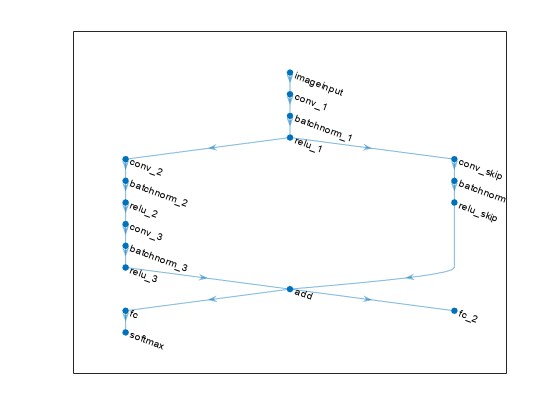connectLayers - Connect layers in neural network - MATLAB (original) (raw)
Connect layers in neural network
Syntax
Description
[netUpdated](#mw%5F245cd580-91e4-4ba0-8efd-73ef7987af1d%5Fsep%5Fmw%5F5956ea1d-4747-411e-8acc-7424b78ab717) = connectLayers([net](#mw%5F245cd580-91e4-4ba0-8efd-73ef7987af1d%5Fsep%5Fmw%5F3ffb42b3-6af7-4c22-82b3-4fb0f6a399f2),[s](#d126e44960),[d](#d126e45001)) connects the source layer s to the destination layerd in the dlnetwork objectnet. The updated network, netUpdated, contains the same layers as net and includes the new connection.
Examples
Create and Connect Addition Layer
Create an empty neural network dlnetwork object and add an addition layer with two inputs and the name 'add'.
net = dlnetwork; layer = additionLayer(2,'Name','add'); net = addLayers(net,layer);
Add two ReLU layers to the neural network and connect them to the addition layer. The addition layer outputs the sum of the outputs from the ReLU layers.
layer = reluLayer('Name','relu1'); net = addLayers(net,layer); net = connectLayers(net,'relu1','add/in1');
layer = reluLayer('Name','relu2'); net = addLayers(net,layer); net = connectLayers(net,'relu2','add/in2');
Visualize the updated network in a plot.

Create Neural Network from Scratch
Define a two-output neural network that predicts both categorical labels and numeric values given 2-D images as input.
Specify the number of classes and responses.
numClasses = 10; numResponses = 1;
Create an empty neural network.
Define the layers of the main branch of the network and the softmax output.
layers = [ imageInputLayer([28 28 1],Normalization="none")
convolution2dLayer(5,16,Padding="same")
batchNormalizationLayer
reluLayer(Name="relu_1")
convolution2dLayer(3,32,Padding="same",Stride=2)
batchNormalizationLayer
reluLayer
convolution2dLayer(3,32,Padding="same")
batchNormalizationLayer
reluLayer
additionLayer(2,Name="add")
fullyConnectedLayer(numClasses)
softmaxLayer(Name="softmax")];net = addLayers(net,layers);
Add the skip connection.
layers = [ convolution2dLayer(1,32,Stride=2,Name="conv_skip") batchNormalizationLayer reluLayer(Name="relu_skip")];
net = addLayers(net,layers); net = connectLayers(net,"relu_1","conv_skip"); net = connectLayers(net,"relu_skip","add/in2");
Add the fully connected layer for the regression output.
layers = fullyConnectedLayer(numResponses,Name="fc_2"); net = addLayers(net,layers); net = connectLayers(net,"add","fc_2");
View the neural network in a plot.

Input Arguments
net — Neural network
dlnetwork object
Neural network, specified as a dlnetwork object.
s — Connection source
string scalar | character vector
Connection source, specified as a character vector or a string scalar.
- If the source layer has a single output, then
sis the name of the layer. - If the source layer has multiple outputs, then
sis the layer name followed by the"/"character and the name of the layer output:"layerName/outputName".
Example: "conv"
Example: "mpool/indices"
d — Connection destination
string scalar | character vector
Connection destination, specified as a string scalar or a character vector.
- If the destination layer has a single input, then
dis the name of the layer. - If the destination layer has multiple inputs, then
dis the layer name followed by the"/"character and the name of the layer input:"layerName/inputName".
Example: "fc"
Example: "add/in1"
Output Arguments
netUpdated — Updated network
dlnetwork object
Updated network, returned as an uninitialized dlnetwork object.
To initialize the learnable parameters of a dlnetwork object, use the initialize function.
The connectLayers function does not preserve quantization information. If the input network is a quantized network, then the output network does not contain quantization information.
Version History
Introduced in R2017b
R2024a: LayerGraph objects are not recommended
Starting in R2024a, LayerGraph objects are not recommended. Usedlnetwork objects instead. This recommendation means that this syntax is not recommended forLayerGraph input:
lgraphUpdated = connectLayers(lgraph,s,d)
Most functions that support LayerGraph objects also supportdlnetwork objects. This table shows some typical usages ofLayerGraph objects and how to update your code to usedlnetwork object functions instead.
| Not Recommended | Recommended |
|---|---|
| lgraph = layerGraph; | net = dlnetwork; |
| lgraph = layerGraph(layers); | net = dlnetwork(layers,Initialize=false); |
| lgraph = layerGraph(net); | net = dag2dlnetwork(net); |
| lgraph = addLayers(lgraph,layers); | net = addLayers(net,layers); |
| lgraph = removeLayers(lgraph,layerNames); | net = removeLayers(net,layerNames); |
| lgraph = replaceLayer(lgraph,layerName,layers); | net = replaceLayer(net,layerName,layers); |
| lgraph = connectLayers(lgraph,s,d); | net = connectLayers(net,s,d); |
| lgraph = disconnectLayers(lgraph,s,d); | net = disconnectLayers(net,s,d); |
| plot(lgraph); | plot(net); |
To train a neural network specified as a dlnetwork object, use the trainnet function.